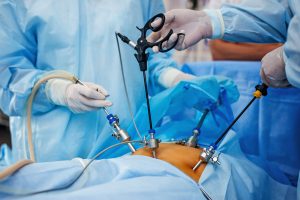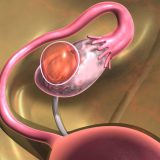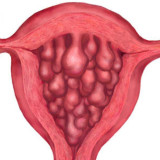Laparoscopy is a modern method of treatment that is often used in treatment of female reproductive system diseases. Doctors resorted to it even when we are talking about a pregnant woman. The procedure is safe, but the patients still have all the same questions. And “pregnancy after laparoscopy” is one of them.
What is laparoscopy
Sometimes, competent and very experienced staff find it difficult to verify the diseases diagnosis. That’s why in modern medicine laparoscopy is widespread and used both in diagnosis and treatment. And it is really the most successful method in cases of abdominal organs disorders.
This surgical method is less traumatic. Because instead of a large incision the smaller (diameter 1.5 cm) ones are made. The gas, usually carbon dioxide, is get into the peritoneum through them. The first cut is carried out for the telescopic tube. One side of it is connected to the lens or camera, and this way the procedure is broadcasted on a regular monitor. The second slit for introducing the instrument manipulator.
When laparoscopy is necessary
The main absolute indication for laparoscopy in gynecology – infertility. Firstly the procedure enables easy and almost painless detecting problems which affect women’s pregnant. And at the same time it can be eliminated immediately. For example, in case of blocked fallopian tubes. It is one of the most common causes of female infertility (thirty percent).
In modern conditions gynecologists and surgeons prescribe laparoscopic investigation for suspected acute diseases. Such as appendicitis and a tubal pregnancy. Especially valuable is that the possibility to detect tubal pregnancy with laparoscopy. There appears the ability to save the fallopian tubes. It will subsequently conceive to prolong pregnancy and give birth to a healthy baby.
The most common cases when laparoscopy is involved are uterine fibroids, ovarian cysts, and other diseases of the pelvis. The surgery is the way to confirm the diagnosis and the treatment method. The effectiveness of treatment is about 8 out of 10 patients.
Preparation for laparoscopy
So laparoscopy is the method of surgical diagnosis and treatment. Consequently, meticulous preparation of the patient is required as well as to any surgical procedure.
In the preoperative study of the patient must include:
- blood test;
- urine analysis
- feces analysis (for study whether helminth’s eggs)
- radiography or fluorography examination (if necessary)
- ECG
- pelvic ultrasound
- inspection about the absence of contraindications for laparoscopic surgery
- strict refusal to take food at least 8 hours before the surgery
After the preoperative preparation to enhance anesthesia the patient takes premedication. Then, an experienced anesthetist enters the patient is most often in the mask anesthesia. During it a mask is applied through a special breathing mixture. In the course of surgery anesthesiologist carefully monitors the performance of breathing with special devices. There is a possibility of surgery held with local anesthesia. It is negotiated individually with each patient.
The technique of laparoscopy
First, the surgical field is processed antiseptic. Then it pumped into the abdomen carbon dioxide that provides upbeat abdominal wall for optimal visualization and improve the approach to the pelvic organs.
Then, through the navel introduced a special needle that carries a small puncture. When abdominal pressure is achieved optimal gas, operating doctor inserts a telescopic tube – a laparoscope. He has a small diameter, and at one end is equipped with a camera. The camera allows to watch every step of the operation on the screen. This allows the doctor to get the most reliable and true picture of the state of internal organs and to draw conclusions on the causes of the appearance of the disease.
Contraindications for laparoscopy
Like any surgical procedure, laparoscopy has contraindications. Absolute contraindications will treat extreme health state of the patient (coma, agony, clinical death). Also expressed pathology of the cardiovascular system, septic processes. Relative contraindications, those that increase the risk in the transaction are:
- Obesity third degree.
- The third trimester of pregnancy.
- The pathology of coagulation.
- Infections.
- The recent abdominal surgery.
Laparoscopy: “pros”
In a progressive modern gynecology laparoscopy there as one of the prospects of having a diagnostic and treatment methods. One of the main reasons for its selection is the small size of the incision, thus avoiding postoperative pain and the formation of rough scars.
There is no need to implement the recommendations of strict bed rest. The ability to work come back to normal in a short time.
Traumatic risks during surgery are minimal. Touching internal organs with latex, operating material, is completely excluded.
Reducing the possibility of the formation of adhesions.
The main advantage is the ability to detect and treat diseases in a single operation and preservation of the functions of organs.
The undoubted advantage of laparoscopy is a short post-operative period, or rather, lack of it, because many patients go home the next day.
Also during the operation, nearby healthy organs are not affected, which ultimately makes pregnancy after laparoscopy real .
Laparoscopy: opinion “against”
The main laparoscopy disadvantage is the use of general anesthesia, as in many surgical operations. The body’s response to anesthesia is different, but often contraindications to it revealed during preoperative preparation. As a result of these specialist anesthetist concludes the risk of general anesthesia for each patient. If there are no other contraindications laparoscopy can be made under local anesthesia.
Laparoscopy can have complications as any other surgery does. But according to statistics, only 15% of women after the surgical intervention have serious difficulties with conception. The rest of the patients get pregnant during the year, earlier or later.
Whether pregnancy after laparoscopy is possible
After the surgery, women wonder if pregnancy after laparoscopy is possible. Reviews on countless forums for moms say that it is possible, the woman just need to follow some rules to avoid possible complications after surgery. Before and during pregnancy after laparoscopy a woman should pay much more attention to her and the baby’s health than in regular cases.
mostly he answer to the question – whether pregnancy after laparoscopy is possible – depends on the success of the procedure and the involved organs. But in any case, it is recommended visit a gynecologist to carry out examinations that include an ultrasound scanner. It allows to monitor the condition of the reproductive organs and determine whether there are any contraindications for pregnancy. If there are some, they are usually temporary. If such contraindications do not exist, the doctor usually recommends to wait about three months after surgery before trying to conceive
Women who have successfully undergone laparoscopy of the fallopian tubes share their own experience, which shows that many doctors say a child can be born ada soon as the woman feels ready – both physically and mentally. Similarly is the case of laparoscopic removal of ectopic pregnancy. Some doctors say the woman can have a baby after the first cycle.
However is worth remembering that each situation is individual and each case is different. It is difficult to generalize in medical matters. Each patient should ask her doctor, whether in her particular case it is necessary to wait before having a child or not.
Of course, there are situations when pregnancy after laparoscopy is impossible. For example, in case after removal of both ovaries. However, the removal of only one ovary does not deprive the chances to conceive at all. In this case it just may take more effort and time, but if ovulation occurs, the woman can still get pregnant
Planning pregnancy after laparoscopy
The basic rule that all women must remember when plan pregnancy after laparoscopy is having no sexual intercourse after the surgery for at least 2-3 weeks. Thus the patient avoids getting infections and, therefore, the problems of women’s health in the future.
In addition, the doctor can assign hormone therapy. After ovulatory menstrual cycles returned to normal, the woman can think of pregnancy after laparoscopy.
It is mandatory to consult a gynecologist and talk about pregnancy after laparoscopy. Appoint a specialist range of medical tests and examinations to help determine the state of your health and rule out other causes of infertility. Also, your partner should also go through the study because 25% of the cause of non-occurrence of pregnancy is the health of men.
















